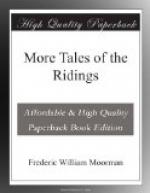“What’s up?” asked one of them of a farmer’s man, as he followed the sound of the hubbub.
“It’s Sam Learoyd,” the man replied, “and he wants to know if onybody’s wantin’ to buy his dowter.”
“Black Sam o’ Fieldhead Farm! By Gow! I reckon he’s bin crazed sin his missus left him for t’ barman. But he hasn’t gotten no dowters, nor sons nowther. It’ll be his stepdowter, Mary Whittaker, that he’s browt to market.”
The speakers were now approaching the spot where the father and the haltered stepdaughter were standing. The former, a hard-featured, sullen man of about forty-five, was addressing the crowd. The latter, hiding as much of her face as she could beneath her grey shawl, stood with her hands clasped before her and her eyes fixed on the ground. Mute resignation was written on every line of her face. Whatever indignation or shame she might feel at the degrading situation in which she was placed seemed repressed, either by the humility that comes from long suffering or by a supreme effort of the will, of which the tightly closed lips gave some indication.
The spot chosen by Sam Learoyd for his traffic in human flesh was not without significance. Behind him, and approached by steps, on which the farmers’ wives exposed for sale their baskets of poultry and eggs, stood what was left of the market cross. It was one of those old Saxon crosses of Irish design which may still be seen in some of the towns and villages of England, and are said to mark the spot where the early Christian missionaries, long before the churches were built, preached their gospel of peace and good will to a pagan audience. Close at hand were the stocks, where, until quite recently, the bullies and scolds of the town had been set by their fellow-citizens and suhjected to the missiles and taunts of every passer-by. Here, then, between these two symbols—the one of Divine mercy and the other of the vindication of popular justice—Mary Whittaker was exposed for sale.
It took some time for the crowd to realise that Learoyd was in earnest. This sale by public auction of a young woman whom many of the bystanders had known for years seemed little better than a grim jest. Yet most were aware that sales like this had taken place in the town before, and deep down in their minds there survived the old primitive idea that the head of a family had a right to do what he liked with the members of his household. There were muttered protests from the few women and some of the older men who were present, but most of the young men, in whom a sense of chivalry had been blunted by hard lahour and penury, found a pleasure in goading the farmer on. No magistrate was at hand to put a stop to the traffic in human life, and the single policeman, realising that he had no written instructions to deal with such a case as this, had discreetly withdrawn himself to the remotest quarter of the town. So Learoyd was left free to conduct his infamous auction.




